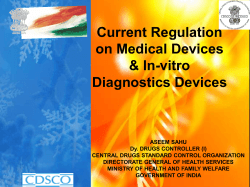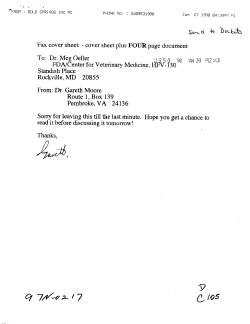
AdvaMed 2014: hot topics •
AdvaMed 2014: hot topics Commoditization is real, and differentiation is an imperative • The strong message from buyers and insurers is “prove it” – demonstrate that products are superior and worth the cost. Industry leaders acknowledge that the move from volume to value is real and that medtech companies have a role in helping providers and policymakers extract more value from the system. • End-to-end solutions, with bundling to provide greater value to an increasingly concentrated customer base, have become a core strategic focus among big medtech companies. Smaller firms, meanwhile, are targeting niches where they can exploit technology and value gaps. (“I’d much rather capture 90% of a $100m market than have 15% of a $5b market.” – CEO of medtech company) • Strategic partnerships outside core competencies can enhance revenue growth and profitability to counteract the headwinds of pricing pressure from buyers and a more onerous FDA approval process. Options may include health care IT, such as telemedicine and supply chain security – particularly around distribution in emerging markets, with China cited as a challenge, and consumer-directed initiatives to drive growth without encountering regulatory approval hurdles. New strategies are needed to accelerate growth • Organic growth is anemic, especially in developed markets. Some expect demographics to bail them out in the near term as baby boomers move into a heavy health care consumption model. Others are diversifying their businesses to focus on products that can sell in growing/emerging markets. Inorganic growth through M&A will be part of the answer for companies with enough firepower to do deals. • Innovation is in real trouble. Venture capital investment in early-stage technologies has slumped (60% of US VC investment went to later-stage companies in 2013). Medtech corporate venture capital has helped fill the gap but prefers not to invest alone. These factors are likely to have a significant impact on the development of new products over the next three to five years. • Health care services remain some way off. But as an outcomes focus becomes an essential differentiator, medtech companies are starting to form partnerships with hospitals. • Obtaining superior clinical data is a challenge, and medtech companies are still struggling to move away from “me-too” positioning. As certain influential payers/buyers pointed out, there is a strong need to be able to critically assess the value of medtech products. At present, most hospitals are more interested in per-product price than outcomes, and less about outcomes at present, perhaps because medtech companies simply don’t have outcomes data that clearly demonstrate the value of particular products. The FDA is on a course for change • The FDA approval process remains a major industry headwind. Venture funds increasingly back medtechs with a strategy of going to market outside the US first, citing the probability of de-risking (via regulatory approval milestones) faster in multiple international markets. Both Hillary Clinton and Medtronic founder Earl Bakken remarked that US regulatory bodies take too long to review life-saving medical devices, diagnostics and therapeutics. • Regulatory complexity and approval barriers are also discouraging innovative product development that combines drugs and devices. • FDA commissioner Margaret Hamburg acknowledged the need to speed up medtech approval times, which could emulate pharma. She cited progress in pharma regulation: expedited review, fast-track approval and breakthrough designation have decreased approval times, delivering value for patients, payers and pharma. Discussion included precompetitive initiatives and increased use of patient registries (outside the US), which offer potentially faster time to market. • Jeff Shuren, Director of the FDA’S Center for Devices and Radiological Health (CDRH), noted that the agency’s future vision will be built around the concept that new technologies should be launched in the US before anywhere else. Shuren previewed new guidance on adaptive clinical trials and biomarkers, as well as an “innovation consortium” intended to provide tools for medtech companies, such as computational modelling, clinical trial innovation and a patient-centered benefit/risk project. Shuren raised the possibility that patient risk/benefit trade-offs could trump reviewers’ concerns to enable a product to get to the market: “We’ll accept more uncertainty but with a reasonable guarantee of safety and effectiveness.” Optimal supply chain and security strategies are emerging • A CEO panel of medtech, distributor and logistics executives discussed opportunities to improve supply-chain efficiency, including shared distribution. “When there’s 400 days of inventory in the channel, that’s an opportunity for the industry to improve.” • Hospital inventory management was also cited as a challenge. Consolidation in the hospital sector with more budget constraints has resulted in fewer products and overall lower inventory on site, which increases the risk of supply shortages. In response, it was suggested medtech could adopt strategies such as managing human resources needs within hospitals – the operating room was a focus – and creative bundling solutions within the supply chain. • Medtech execs see the increasing number of product recalls in medtech as symptomatic of the fact that the bar for quality is being raised everywhere. The industry is working closely with the FDA to reduce recalls and ensure supplies meet patient needs. Biomarkers and diagnostics will play a bigger role in reimbursement • Increased use of biomarkers to stratify patient populations should lead to better capture of the economic value of products (look for new CDRH guidance on biomarkers soon). Diagnostics enable this process and will encourage the evolution of new partnering models in the industry, sharing value across diagnostics, pharma, providers and payers. • Complicating this progress is the current state of reimbursement uncertainty for molecular diagnostics. The current model of “one test per marker” does not always command higher pricing power with payers; more often than not it is pharma companies, rather than payers, who support this diagnostics approach as they seek to demonstrate the value of therapies. • Novel diagnostics (e.g., next-generation panel sequencing) and new biomarkers are poised to capture more value, but are only just beginning to play out commercially. ACA: one year on, the challenges are clear • Medtech companies are wrestling with the challenge of high up-front deductibles ($2,500–$5,000) that are greater than most private pay corporate-sponsored insurance plans. • Some executives see the Affordable Care Act (ACA) as offering new opportunities for partnering in the medtech space. • The Medical Technology Excise Tax still rankles, but there is also a sense that it is old news. Companies have moved their focus away from it. For more information, please contact: Glen Giovannetti EY Global Life Sciences Leader +1 617 374 6218 glen.giovannetti@ey.com Jeffrey Greene EY Global Transactions Leader, Life Sciences +1 212 773 6500 jeffrey.greene@ey.com Patrick Flochel EY Global Pharmaceutical Leader and EMEIA Life Sciences Leader +41 58 286 41 48 patrick.flochel@ch.ey.com John Babitt EY Americas Medtech Leader +1 212 773 0912 john.babitt@ey.com EY | Assurance | Tax | Transactions | Advisory © 2014 EYGM Limited. All Rights Reserved. EYG no: FN0177
© Copyright 2025














